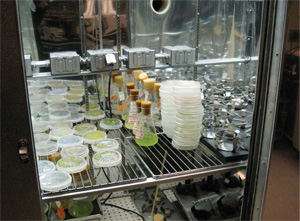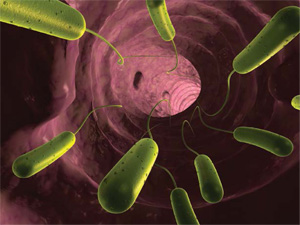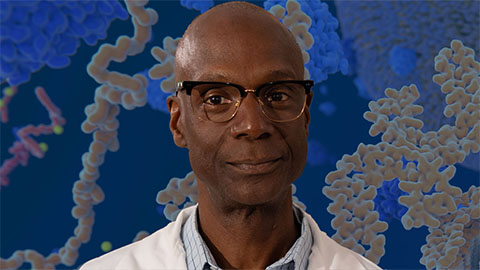Synthetic biology: edging toward the clinic
Slowly, slowly, synthetic biology has been inching toward clinical applications. Those closest to this decade-old field say the time has come to test it against some of the most pressing global clinical challenges.
The goal of synthetic biology is the manipulation of biological cells in a predictable and rational fashion at the molecular level to carry out a given task efficiently and reliably at a cost of mere pennies. James J. Collins, a Howard Hughes Medical Institute investigator at Boston University, explains that over time, the community has become more efficient and savvy in manipulating biomolecules “to reprogram organisms and endow them with novel functions.” While some researchers are focusing on environmental, energy, and commodity chemical production issues, others are tackling longstanding biomedical problems (1, 2).
Some significant steps have been taken recently on the clinical front: Specially designed microorganisms can synthesize critical drugs, and a device has been created to track ovulation in cows for the dairy and livestock industry. Academic research laboratories are pushing for human therapies, such as re-engineering probiotic bacteria to tackle cholera. The brass ring in the field is to re-engineer cells taken from patients and put them back in to cure complex diseases.

'What’s in a name?'
But in discussing synthetic biology, a schism appears. A PubMed search for “synthetic biology” in journal article titles pulls up 310 articles since 2003. Obviously, there are researchers who believe that synthetic biology is a bona fide field. But some researchers, like John C. March of Cornell University and Andrew D. Ellington at the University of Texas at Austin, assert that “synthetic biology” is just a buzz phrase.
“What does synthetic biology have to offer? Perhaps it is a new way to look at things, but really many of the same thrusts have been proceeding under the rubric of biotechnology, molecular biology and bioengineering,” says Ellington. “This cobbled-together field adopted a name, but that doesn’t mean it has any sort of intellectual center or gravitas.”
March says he hasn’t seen anything in the literature that suggests synthetic biology “is a new science.” He sees it largely as sophisticated genetic engineering. Journal articles about synthetic biology don’t describe anything more than “taking genes out of one organism and putting them in another and looking more at the transcriptional control of gene expression,” which has been done for over 30 years, says March.
Collins says he understands the criticism. Synthetic biology is closely related to genetic engineering and “utilizes the tools and methods that were developed as part of genetic engineering,” says Collins. “It’s genetic engineering on technological steroids.” He and other self-described synthetic biologists say genetic engineering tends to focus on individual genes, while synthetic biology strings together a series of molecular components, such as DNA, RNA, proteins and cells, into circuits and networks.
“Conventional genetic engineering often refers to cutting and pasting genes from one place to another without fine control over how the genes are regulated or a clear understanding of all the detailed molecular mechanisms,” explains Timothy K. Lu at the Massachusetts Institute of Technology. “Synthetic biology puts a lot more emphasis on separating out components into individual modules and functions,” such as understanding how to quantitatively control translation and transcription rates. In addition, synthetic biologists don’t want to pursue the one-time genetic engineering of an organism but want “to build a set of tools that will allow you to do many types of modifications, regardless of your end application, much more rapidly, quantifiably and predictably,” says Lu.
First indications of clinical applications
Regardless of whether you call it synthetic biology or improved genetic engineering, the field has begun to make some headway in clinical applications, such as using engineered microorganisms for cost-effective, timely and robust drug production. An example is artemisinin, an anti-malarial drug whose extraction from the Chinese sweet wormwood plant is inefficient and expensive. Given that every year, malaria infects 300 million to 500 million people and causes 1 million to 2 million deaths, mostly in the developing world, cheaper and more readily available sources of artemisinin-type drugs are urgently needed.
Jay D. Keasling’s laboratory at the Lawrence Berkeley National Laboratory and the University of California, Berkeley, armed with a $42.5-million grant from the Bill and Melinda Gates Foundation, engineered Saccharomyces cerevisiae to produce artemisinic acid, which is readily converted into artemisinin by chemical means. To engineer the yeast, the researchers first created a new metabolic pathway in the microorganism. Next, they placed bacterial and wormwood genes in the yeast genome so that the products of those genes interacted in the new metabolic pathway to produce a precursor to artemisinic acid. The researchers also then added in the wormwood cytochrome P450 gene so the this precursor would be converted to artemisinic acid.
The researchers estimated their method could produce the drug for 25 cents per treatment. The conventional approach of extracting artemisinin from the plant costs about $2. This year, Sanofi-Aventis licensed the technology to optimize it and scale it up. The company hopes to have synthetic artemisinin in the supply chain by 2013.
A more complicated application of synthetic biology involves engineering biological components to work inside a mammal. In the dairy and livestock industries, farmers struggle to determine when a cow is ready to be impregnated, which they do by observing the cow’s behavior. But even if they correctly guess when a cow is ovulating, artificially inseminating the cow with sperm from a plastic tube has only a 40 percent success rate.
Earlier this year, Martin Fussenegger’s group at the Swiss Federal Institute of Technology (ETH) in Zurich developed a capsule made from cellulose polymers (3). Into the capsule they placed sperm and engineered mammalian cells that detected luteinizing hormone (the ovulation signal) and produced cellulase in response. The capsule works like this: A farmer tracks an animal’s 21-day ovulation cycle and notes when ovulation is most likely to start. The capsule keeps the sperm fresh for three days, so a vet inserts the capsule into the cow’s uterus a day or two before ovulation. When luteinizing hormone surges through a the cow, the engineered cells inside the capsule detect it and initiate the expression of cellulases. The cellulases degrade the capsule and release the sperm. In the first trial run carried out in Switzerland, Fussenegger says the device had a 100 percent success rate.
Other efforts to develop clinical therapeutics are still in the laboratory testing phase. For example, researchers are looking to exploit the commensal bacteria that reside in the gut. “There are a number of things these bacteria normally do daily in the intestine that we just haven’t tapped into,” says March. “There is no reason why we couldn’t engineer them to act on the behalf of their host rather than just on their own behalf.”
March’s team has manipulated commensal bacteria to treat cholera. Vibrio cholerae, the bacterium that causes the infection, populates the upper intestine and reaches a certain density after which it stops making its colonization proteins. It then exits the body by diarrhea, causing life-threatening dehydration in victims. March’s team decided to beat V. cholerae at its own game by getting a probiotic Escherichia coli strain to produce the signature quorum-sensing V. cholerae proteins. “If [E. coli bacteria] were making the signal and a V. cholerae bacterium came in, it would think other V. cholerae were already there. It wouldn’t attach,” says March. The investigators were successful in getting the method to work in a mouse model last year (4).
Cholera is rampant in the developing world, where affected populations often can’t afford the two vaccines currently available for more than $1.50 per dose, . March’s approach with engineered commensal bacteria would be relatively inexpensive: The bacteria could be laced into fermented foods, such as yogurt, and passed through communities as fermentation starters without incurring costs.
Cancer therapies also are being pursued. Current methods often cause unpleasant side effects in patients, because they take down healthy as well as cancerous cells. Ron Weiss’ group at MIT, in collaboration with the laboratory of Yaakov Benenson at ETH Zurich, described a system earlier this year that distinguished HeLa cells from normal ones in a mixed- cell culture with great specificity (5). The system used small interfering RNA to measure the expression of six microRNAs that marked cells as cancerous: Three of the microRNAs were typically overexpressed in HeLa cells, while the remaining ones were expressed at extremely low levels. When the magic combination of the six different expression levels of the microRNAs identified the cell as being HeLa, the artificial system triggered apoptosis in the cell. Weiss says the approach of using six different microRNA markers is much more sophisticated and specific than current therapies, which often rely on a single biomarker and are more prone to mistakes.

The approach can be generalized for other types of cancer cell types and could accommodate other types of biomarkers, such as messenger RNAs and proteins, because “we look for the symptoms, not the underlying cause” of the cancer, says Weiss. Because each cell type has a unique combination of biomarkers, he says, it’s a matter of identifying those unique features of each cancer cell type for targeting purposes.
Technical difficulties
As with anything scientifically ambitious, the technical hurdles in synthetic biology are enormous at the early stages. To begin with, the experts say they need to expand the number of well-characterized molecular tools. “It would be so great to have a whole toolkit of well-characterized components sitting on the shelf that we could mix and match,” says Keasling. Meanwhile, Collins explains that the present-day tools of molecular biology “are relatively small and narrow, whether it’s Tet- or Lac-based systems or T7 phage.” He says there are numerous molecular parts that “are not sufficiently characterized or developed to be used as tools in synthetic biology.”
This is where the trove of molecular biology literature comes in, points out Pamela A. Silver of Harvard University. The old literature, she says, is “ripe with things that we can use as parts to build devices.” Silver gives the example of lambda phage, the subject of much research over the past 30 years. “The beauty of that work is that it was done in a lot of detail, and now we can turn around and apply it in a very quantitative and predictable way.”
The complexity of biology is challenging on two levels. First, interactions of synthetic components with endogenous players in different pathways within a given cell are inevitably a problem, says Keasling. Modern technologies that look at large ensembles of molecules, such as DNA arrays, proteomics and metabolomics, help us to understand how pathways are connected to one another. However, the introduction of a synthetic pathway may accidentally set off different pathways, he says, adding that, with the knowledge gained from these technologies, it’s often possible to re-engineer synthetic components to minimize interference.
Then there is the interaction of the engineered entity with the mammalian system. Fussenegger explains that researchers are just coming to grips with the complexities of human systems. “We still do not understand the dynamics of systems biology. We do not even understand the differences among humans in terms of genome,” he says. “If you want to implant something which interfaces with a very complex system, this is very difficult.” The complexity worries March: He says purported synthetic biology tools currently developed may get lost in the noise of complex systems.
This is why “synthetic biology is giving way to systems biology,” says Ellington. He explains that no matter how independent on paper a synthetic pathway appears to be from endogenous pathways in a cell on paper, it’s “going to interact with transcription, translation and signal transduction. Many of the ways in which it does interact are going to be unknown prior to implantation.”
Ellington says molecular biologists can’t always predict outcomes of genetic manipulations. If the outcome of a simple genetic manipulation can’t be predicted with certainty, it’'s going to be “very difficult to predict the outcome of a complex engineered biological system within a human. It’s a fact we encounter regularly at a simpler level with the unanticipated consequences of gene therapies,” he says.
Synthetic biologists disagree. “Synthetic biology aims at creating new forms of life, genetic circuits and behaviors in cells. Systems biology looks at existing natural systems and tries to understand how they work,” says Weiss. Although the two may have some procedures in common, they have “very different perspectives but more importantly, different goals,” he says. Lu further expands by saying the modus operandi of synthetic biology is to have better quantitative control over “molecular engineering techniques that others have been doing over the last 20 years” with higher throughput and predictable and logical properties.
‘Why wait?’
By any name, the endeavor to create artificial biological systems for clinical applications will raise some fundamental questions: What happens to engineered cells when they enter complex mammalian systems? How stable will these engineered entities be in complex environments, and how long will they last? Can parts engineered for one particular mammalian system be translated easily to another? And do the engineered components actually do what they are supposed to do and not unwittingly unleash more havoc? Because of these unanswered questions, synthetic biologists are taking it slowly, keenly aware of the possibility of a backlash suffered in related fields, like the one that followed early attempts in at gene therapy. Those interviewed for this story say it will be at least five years before there are clinical trials will be run using synthetic biology components.
But with all these questions hounding the field, one may very well ask if synthetic biology is even ready for clinical applications. Keasling says he has heard the criticism before. But his response is this: “Why wait?”
Keasling says there is enough knowledge in some areas of biology to have well-characterized components that can be used for initial synthetic biology applications. By pushing on the boundaries into of the unknown, both synthetic biology and its foundation, molecular biology, stand to benefit. For example, Lu says, by delving into the mechanics of how to solve certain disease states, “synthetic biology can help us understand disease processes more efficiently” at the molecular level.
But he and others say synthetic biologists will need time, investment and collaborative efforts to figure out the best means of delivering safe and effective therapeutics to patients. As Lu notes, “The road is going to be a long one.”
References
-
Ruder WC, Lu T, Collins JJ. Synthetic biology moving into the clinic. (2011) Science. 333, 1248 – 1252
- Chen YY, Smolke CD. From DNA to targeted therapeutics: bringing synthetic biology to the clinic. (2011) Sci. Transl. Med. 3, 106ps42
- Kemmer C, Fluri DA, Witschi U, Passeraub A, Gutzwiller A, Fussenegger M. A designer network coordinating bovine artificial insemination by ovulation triggered release of implanted sperms (2011) J. Control Release. 150, 23 – 29
- Duan F, March JC. Engineered bacterial communication prevents Vibrio cholerae virulence in an infant mouse model. (2010) Proc. Natl. Acad. Sci., USA, 107, 11260 – 11264
- Xie Z, Wroblewska L, Prochazka L, Weiss R, Benenson Y. Multi-input RNAibased logic circuit for identification of specific cancer cells. (2011) Science. 333, 1307 – 1311.
Enjoy reading ASBMB Today?
Become a member to receive the print edition four times a year and the digital edition monthly.
Learn moreGet the latest from ASBMB Today
Enter your email address, and we’ll send you a weekly email with recent articles, interviews and more.
Latest in Science
Science highlights or most popular articles

Unraveling the language of histones
Philip Cole presented his research on how posttranslational modifications to histones are involved in gene expression and how these modifications could be therapeutically targeted to treat diseases like cancer.

How Alixorexton could transform narcolepsy treatment
A new investigational drug, alixorexton, targets the brain’s orexin system to restore wakefulness in people with narcolepsy type 1. Alkermes chemist Brian Raymer shares how molecular modeling turned a lab idea into a promising phase 3 therapy.

Phosphatases and pupils: A dual legacy
Yale professor Anton Bennett explores how protein tyrosine phosphatases shape disease, while building a legacy of mentorship that expands opportunity and fuels discovery in biochemistry and molecular biology.

Extracellular vesicles offer clues to cattle reproduction
Extracellular vesicles from pregnant cattle support embryo development better than laboratory models, highlighting their potential to improve reproductive efficiency in bovine embryo cultures. Read more about this recent MCP paper.

Proteomics reveals protein shifts in diabetic eye disease
Using proteomics, researchers identified protein changes in eye fluid that mark diabetic retinopathy progression and may serve as biomarkers for vision-threatening complications. Read more about this recent MCP paper.

Protein modifications drive lung cancer resistance
New assay enriches protein modifications in a single process, enabling detection of key changes in drug-resistant lung cancer cells that may guide future therapies.

